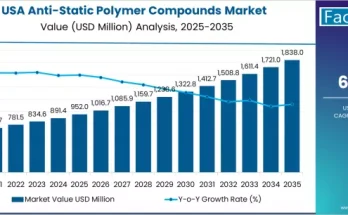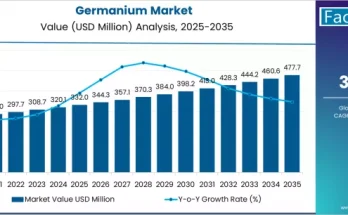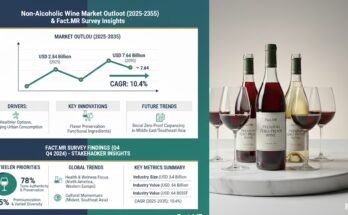The global asphalt anti-strip market is on a steady growth trajectory, fueled by expanding infrastructure development, government investments in road maintenance, and increasing demand for durable pavement solutions. Valued at USD 1.1 billion in 2025, the market is projected to reach USD 1.6 billion by 2035, recording an absolute increase of USD 500 million over the forecast period. This reflects a CAGR of 3.9% during the assessment period, according to the latest analysis by Fact.MR.
As global road construction activities surge, the need for high-performance asphalt mixtures that resist stripping and moisture damage has become a critical focus for contractors and governments. Asphalt anti-strip additives play a vital role in extending pavement life, improving adhesion between aggregates and bitumen, and reducing costly maintenance cycles.
Market Drivers: Infrastructure Expansion, Moisture Resistance, and Sustainability Trends
Global Infrastructure Development and Road Expansion
Growing urbanization and government-backed infrastructure programs are propelling demand for long-lasting roads and highways. The adoption of asphalt anti-strip additives ensures enhanced performance under varying climatic and traffic conditions, making them a preferred choice for modern road projects.
Enhanced Moisture Resistance and Pavement Longevity
Moisture-induced stripping is one of the most common causes of asphalt failure. The use of anti-strip agents improves adhesion and prevents premature pavement damage. Chemical additives such as amines, polymers, and silanes are gaining traction for their ability to improve durability, reduce maintenance costs, and support sustainable construction practices.
Sustainability and Eco-Friendly Solutions
With increasing focus on sustainability, manufacturers are developing eco-friendly and bio-based anti-strip additives that reduce VOC emissions and environmental impact. The integration of these solutions into circular economy models aligns with global green infrastructure initiatives and carbon neutrality targets.
Technological Advancements in Asphalt Additives
Ongoing R&D efforts are driving the evolution of advanced anti-strip formulations compatible with both hot mix and warm mix asphalts. Innovations in amine-based and liquid anti-strip technologies are enhancing compatibility with diverse bitumen grades and aggregate types. Manufacturers are also integrating digital monitoring and AI-driven process optimization to ensure consistent performance across different climatic zones.
Regional Insights: North America Leads, Asia-Pacific Emerges as Growth Hub
- North America – Market Leader in Asphalt Additive Adoption
The U.S. continues to dominate due to large-scale highway rehabilitation projects, stringent construction standards, and well-established supply chains for asphalt materials. - Europe – Emphasis on Sustainable Road Construction
Countries like Germany, France, and the U.K. are focusing on eco-friendly and long-lasting road materials supported by EU sustainability goals and funding programs. - Asia-Pacific – Fastest Growing Market
Rapid urbanization and infrastructure investments in India, China, and Southeast Asia are boosting market expansion. Increasing government initiatives for smart cities and road modernization are further propelling regional growth.
Competitive Landscape
The asphalt anti-strip market is characterized by strategic collaborations, technological innovation, and product diversification. Leading players are focusing on formulating high-performance additives that meet stringent environmental and performance standards.
Key Players in the Asphalt Anti-Strip Market:
- Arkema
- ArrMaz
- Ingevity
- Evonik
- AkzoNobel
- Kao Corp
- Huntsman
- Dow
- Nouryon
- Road Science
These companies are investing in R&D to develop advanced adhesion promoters, bio-based additives, and region-specific formulations. Strategic partnerships with road authorities and asphalt producers are helping them strengthen their global footprint.
Recent Developments
- July 2025 – Ingevity announced a new generation of bio-based anti-strip agents designed to enhance adhesion and reduce environmental impact in warm-mix asphalt applications.
- March 2024 – Evonik introduced a silane-based adhesion promoter that enhances water resistance and durability of asphalt pavements in high-moisture regions.
Future Outlook: Toward Smart and Sustainable Road Networks
The next decade will witness a shift toward smart infrastructure and green construction materials, with asphalt anti-strip additives playing a central role in improving pavement performance and sustainability. Key trends shaping the future include:
- Development of bio-based and non-toxic additives
- Integration of IoT-enabled monitoring for pavement health
- Expansion of recycled asphalt usage with compatible anti-strip technologies
- Global standardization of quality parameters for better interoperability
By 2035, the asphalt anti-strip market will be a cornerstone of advanced road infrastructure, combining performance, sustainability, and cost efficiency.



